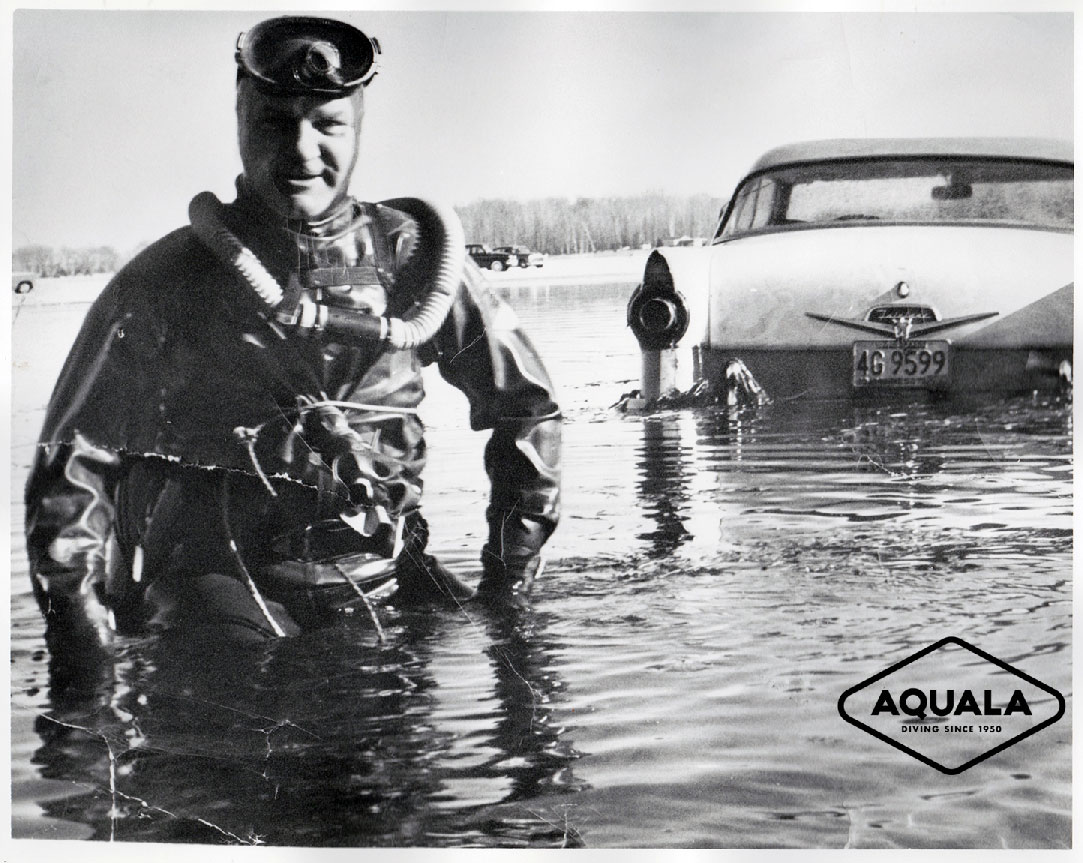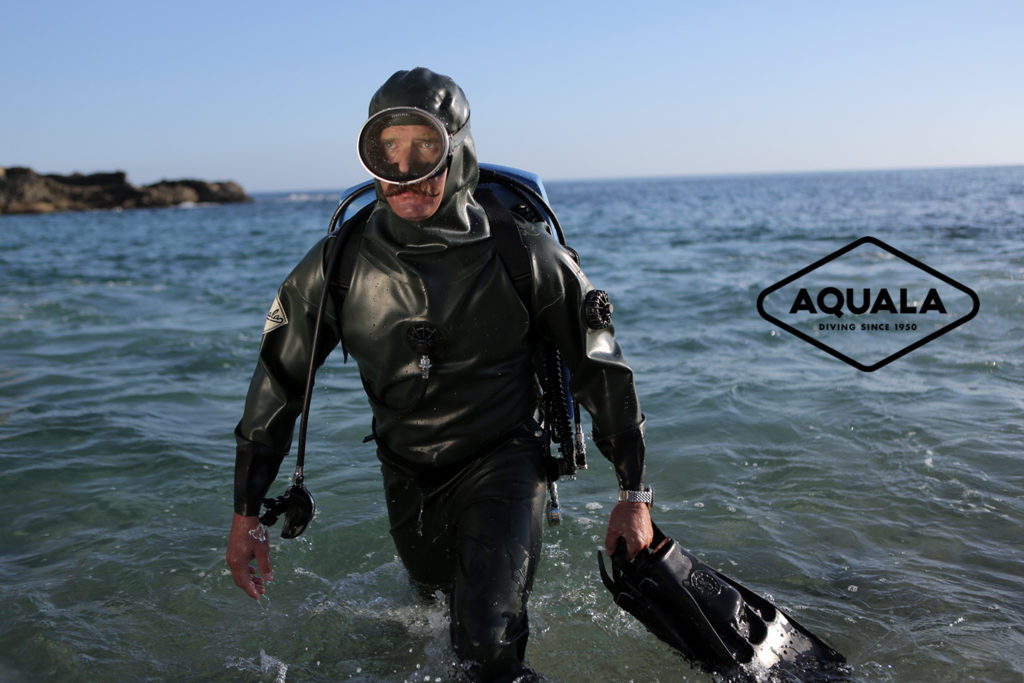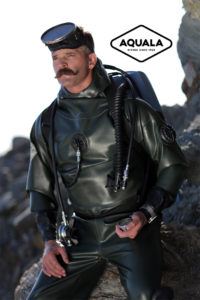The Global Family of Vintage Diving
When I decided to refocus the line, authenticity and detail were key to the new direction. While we’ve had a “historical” model, which was essentially the same as a Coronado since 2002, we didn’t have a suit that bridged the gap between our very first tunnel entry design, and our current triple seamed, pressures valved model.

Over the years I’ve built a respectable archive of vintage suits, so I unboxed several and began to look around. Many of these suits hadn’t been seen in over ten years.

Jack “The Frogman” Blocker.
There were suits that had been sent to us from a retired abalone diver, suits from “Jack the Frogman” Blocker’s old dive shop that had been sealed away for decades (that’s another story unto itself). There were suits that had been sent to us from the director of diving at the National Oceanic and Atmospheric Administration (NOAA) after cleaning out their dive locker, suits that I had picked up on eBay, and there were suits that I had no idea where they came from. There were suits from the ‘50s, going all the way through the ‘80s, so I had everything I needed to find the next model.
As I unboxed and unfolded, the ‘70s vintage suits began to stand out. What I noticed was how the zipper patch was constructed around the OEB waterproof zipper. It was different from the one-piece design that we were currently using, and then I remembered some cutting dies that I found years ago in a box. When I took over Aquala from John Meehan in Rye New Hampshire, there were tools and templates that I had no idea what they were. They weren’t relevant to what we were currently making, so they were tucked away and essentially forgotten.
The other differing features on those ‘70s suits are the valves. Most were made by Poseidon and were a design that hadn’t been made in years. At this point, the idea of reproducing a ‘70s style drysuit was beginning to take shape. There was one problem, while we could use the old cutting dies to recreate the zipper construction, there was no way to recreate the valve unless tens of thousands of dollars were invested in tooling. It just wasn’t worth it. That’s when I remembered a simple valve that I one time stocked to be used on a heavy-duty commercial suit that we once made. The valve had a clean vintage look, and it functioned exactly like a valve from the ‘70s. The name had escaped me over the years, but after scouring through a few file drawers, I found what I was looking for, Delphi O.E.M. That file produced an email, and luckily after a quick search, discovered they were still in business.
Now I had everything I needed to produce a suit that bridged the gap between the ‘50s and ‘60s of our tunnel suit, and the 2000s of our then current model. The Monterey drysuit was born with vintage style zipper construction, vintage style valves, and even NOS ‘70s logo patches. There was a full box of those when I took over from John Meehan.

After putting in the hours to ensure that our Coronado and Monterrey models were as historically authentic as possible, authenticity and attention to detail didn’t stop there. I couldn’t let it. When it was time to have all of the suits photographed on location, that authenticity and attention to detail had to carry through to everything else. The equipment used had to be just as detailed and period correct as the suits themselves, and that’s when the real research began.
How did it all happen? Many hours of research began by contacting a vintage and Historical Diving Society buddy named Mark Howell. Mark and I had become friends through the HDS back in the early 2000s but had lost touch over the years. Mark had one of our “Historical” models and used it with vintage equipment for vintage dive demos at some aquariums out in California. Once I found him, he was in.
From there I joined two of the vintage scuba diving forums, and began to ask questions and learn. I sourced old equipment catalogs from the eras of interest. When I needed help with Scubapro history and archives, I contacted my Scubapro sales rep buddy, Fraser Purdon. Fraser came through as always.
The amazing thing is that everyone was willing to help. The guys from the vintage forums, not only did they help with information (like David Wilson, Jay Slean, and John Ratliff) but they pulled vintage gear from their own collections and made them available for the project. Guys like Andy Bard, Russel Kolifrath, Michael Story, Charlie Notthoff, and Rob Studnicky of The Scuba Museum all helped with the gear that made this part of the project possible. Everywhere I turned, even my local dive shop buddy Jason Feldt, contributed to the cause.
After the shoot, as my research continued, the willingness to help hasn’t stopped. This past week I was researching the ScubaPro depth gauge that I used in the Monterrey sequence. I knew the years it was produced, but I knew nothing about the Italian company, SOS, who made it. My first step was to reach out to my friend and Historical Diving Society historian, Ed LaRochelle. Ed put me in contact with HDS Germany, and they put me in contact with HDS Italia. Within 48 hours my question had traveled around the world, and I had the information I was looking for. Thank you Franz Rothbrust, Frank Wurthwein, Rossella Paternò, and Luigi Fabbri.
Monterrey sequence. I knew the years it was produced, but I knew nothing about the Italian company, SOS, who made it. My first step was to reach out to my friend and Historical Diving Society historian, Ed LaRochelle. Ed put me in contact with HDS Germany, and they put me in contact with HDS Italia. Within 48 hours my question had traveled around the world, and I had the information I was looking for. Thank you Franz Rothbrust, Frank Wurthwein, Rossella Paternò, and Luigi Fabbri.
I’ve been on the dive scene since ‘84 and I’ve seen rivalries over different philosophies and approaches many times. While it’s great to be passionate about something, I have yet to find any egos or attitudes from the vintage and historical community. The entire process has been a blast because of the great people who have come together to help make it happen.
What we do at Aquala might be about building a diving suit, but we’re really building something bigger. We’re building a community of those who keep the history alive. We’re building a network of those who appreciate the past but look to the future. It’s diving with friends, and it’s diving with family. Whether they’re right here in the US or all around the world, we’re building a team, and we hope that you will join us.
Ty Alley